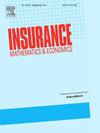Insurance loss modeling with gradient tree-boosted mixture models
IF 2.2
2区 经济学
Q2 ECONOMICS
引用次数: 0
Abstract
In actuarial practice, finite mixture model is one widely applied statistical method to model the insurance loss. Although the Expectation-Maximization (EM) algorithm usually plays an essential tool for the parameter estimation of mixture models, it suffers from other issues which cause unstable predictions. For example, feature engineering and variable selection are two crucial modeling issues that are challenging for mixture models as they involve several component models. Avoiding overfitting is another technical concern of the modeling method for the prediction of future losses. To address those issues, we propose an Expectation-Boosting (EB) algorithm, which implements the gradient boosting decision trees to adaptively increase the likelihood in the second step. Our proposed EB algorithm can estimate both the mixing probabilities and the component parameters non-parametrically and overfitting-sensitively, and further perform automated feature engineering, model fitting, and variable selection simultaneously, which fully explores the predictive power of feature space. Moreover, the proposed algorithm can be combined with parallel computation methods to improve computation efficiency. Finally, we conduct two simulation studies to show the good performance of the proposed algorithm and an empirical analysis of the claim amounts for illustration.
梯度树增强混合模型的保险损失建模
在精算实践中,有限混合模型是一种应用广泛的保险损失模型统计方法。期望最大化(EM)算法通常是混合模型参数估计的重要工具,但它也存在其他导致预测不稳定的问题。例如,特征工程和变量选择是两个至关重要的建模问题,这对混合模型来说是具有挑战性的,因为它们涉及多个组件模型。避免过拟合是预测未来损失的建模方法的另一个技术问题。为了解决这些问题,我们提出了一种期望增强(EB)算法,该算法实现了梯度增强决策树,以自适应地增加第二步的可能性。我们提出的EB算法可以非参数化和过拟合敏感地估计混合概率和成分参数,并进一步同时进行自动化特征工程、模型拟合和变量选择,充分挖掘了特征空间的预测能力。此外,该算法可以与并行计算方法相结合,提高计算效率。最后,我们进行了两项模拟研究,以显示所提出算法的良好性能,并对索赔金额进行了实证分析。
本文章由计算机程序翻译,如有差异,请以英文原文为准。
求助全文
约1分钟内获得全文
求助全文
来源期刊

Insurance Mathematics & Economics
管理科学-数学跨学科应用
CiteScore
3.40
自引率
15.80%
发文量
90
审稿时长
17.3 weeks
期刊介绍:
Insurance: Mathematics and Economics publishes leading research spanning all fields of actuarial science research. It appears six times per year and is the largest journal in actuarial science research around the world.
Insurance: Mathematics and Economics is an international academic journal that aims to strengthen the communication between individuals and groups who develop and apply research results in actuarial science. The journal feels a particular obligation to facilitate closer cooperation between those who conduct research in insurance mathematics and quantitative insurance economics, and practicing actuaries who are interested in the implementation of the results. To this purpose, Insurance: Mathematics and Economics publishes high-quality articles of broad international interest, concerned with either the theory of insurance mathematics and quantitative insurance economics or the inventive application of it, including empirical or experimental results. Articles that combine several of these aspects are particularly considered.
 求助内容:
求助内容: 应助结果提醒方式:
应助结果提醒方式:


